- Home
- Lawrence Block
The Crime of Our Lives Page 3
The Crime of Our Lives Read online
Page 3
James M. Cain (1892-1977)
While he is generally regarded as one of the seminal figures of hardboiled crime fiction, Cain would have no part of it. “I belong to no school, hardboiled or otherwise,” he insisted.
Oh, well. The writer is always the last to know. On the basis of two books, The Postman Always Rings Twice and Double Indemnity, Cain’s place in the field is assured. He wrote sparely and convincingly of ordinary and fundamentally decent human beings moved by sexual passion to commit murder for gain. A whole generation of strong American fiction, the archetypal gold-medal novels of Charles Williams and Gil Brewer and others, springs directly from these two books.
Not everyone admired him. “Everything he touches smells like a billy goat,” Raymond Chandler complained. “He is every kind of writer I detest, a faux naïf, a Proust in greasy overalls, a dirty little boy with a piece of chalk and a board fence and nobody looking.”
Hey, don’t hold back, Ray. Tell us what you really think.
I always think of Cain when the subject of film adaptation comes up. Several of his novels were filmed, and he was often asked how he felt about what Hollywood had done to his books. “But they have done nothing to my books,” he would reply. “They are right over there on the shelf, exactly as I wrote them.”
Raymond Chandler (1888-1959)
Chandler has long been the intellectual’s darling, a mystery writer for people who don’t like mysteries. On the one hand, he talked of taking murder out of the English drawing room and putting it in the streets where it belonged. At the same time, his characters spent a surprising amount of time in the homes and haunts of the California rich, a West Coast equivalent of the country house on the moors. His achievement, it seems to me, is less that he brought the traditional mystery into the alleys and gutters than that he put a novelist’s spin on the pulp tradition of Dime Detective and Black Mask.
All the novels are first-rate, except for Playback, a tired and confused effort published a year before the author’s death. I suppose my own favorite is The Long Goodbye, which shows rather more of Chandler’s detective Philip Marlowe than did any of the previous books. In its exploration of Marlowe’s friendship with Terry Lennox, the book is as much a novel of character as of plot. If ultimately flawed, The Long Goodbye thereby fits Randall Jarrell’s definition of a novel—a lengthy prose narrative that’s got something wrong with it.
Stanley Ellin (1916-86)
Stanley Ellin was a perfectionist, working slowly and deliberately, producing a page of typescript on a good day. He admitted to having rewritten the opening paragraph of a short story as many as forty times before going on to the next paragraph and polishing each subsequent page in similar fashion before proceeding further.
It is possible to write short stories in this fashion, and Ellin consistently wrote the best mystery short stories of his time. His very first published story, “The Specialty of the House,” endures as a classic, although it is probably less surprising to today’s reader simply because so much fuss has been made about it. But all of Ellin’s stories are wonderful. He managed only one a year, sent each in turn to Ellery Queen’s Mystery Magazine, and never had one rejected.
He received more financial remuneration, if less critical acclaim, for his novels. (He did not write them as slowly and laboriously as the stories. You can’t.) An early private-eye novel, The Eighth Circle, impressed me when I read it years ago. His later novels never worked terribly well for me, but the short stories are timeless, and a national treasure.
Erie Stanley Gardner (1889-1970)
Eighty-two novels about Perry Mason. Nine about D.A. Doug Selby. Twenty-nine (under the name A. A. Fair) about the private-eye team of Donald Lam and Bertha Cool. If Stanley Ellin crept through his stories at a snail’s pace, Erie Stanley Gardner wrote like a man with his hair on fire.
I discovered Perry Mason when I was twelve, and I don’t know how many of the books I read over the next three or four years. They were relentlessly formulaic, and in a sense, if you’d read one, you’d read them all. On the other hand, if you enjoyed one, you would enjoy them all.
The prose narration was sloppy, the descriptions clichéd. Gardner hurried through those parts, and so does the reader. But the dialogue, effortless for the author, was absolutely masterly, and the courtroom scenes, however unrealistic they may have been, worked magically upon the page.
Mason himself changed over the years. In the earlier books he himself was a shady character, willing to bend and even break the law in the service of a client. He grew respectable in his middle years, when most of his cases were serialized in The Saturday Evening Post, and he turned staid and dull later on.
After a period of neglect Perry Mason seems to be coming back into favor with readers. Try one of the pre-war Masons—The Case of the Sulky Girl is a good one—or any of the A. A. Fair books. The latter are very different, breezily narrated by Donald Lam, and characterized by much better writing than the Masons.
Dashiell Hammett (1894-1961)
Hammett’s colossal reputation rests upon a very small body of work. After several years laboring for the pulps, he published five novels in as many years, then wrote virtually nothing for the remaining twenty-seven years of his life. And the last of the novels, The Thin Man, is really not much good.
No matter. The others are superb, as impressive now as when they were written more than a half-century ago.
Hammett was a Pinkerton detective before he started writing, and his experience informs his work. But his greatness is far more than a matter of being able to write knowledgeably of crime and criminals. Both his literary style and his artistic vision cast an unsparing light on Prohibition-era America. In sentences that were flat and uninflected and remarkably nonjudgmental, he did much the same thing Hemingway did. I would argue that he did it better.
The Maltese Falcon is my own favorite, and the Bogart film won’t spoil it for you; the book quite literally is the John Huston screenplay.
Chester Himes (1909-84)
If Hammett brought the special perceptions of a detective to crime fiction, Chester Himes came at it from the other side. He began writing toward the end of a seven-year stretch in an Ohio state penitentiary. His first books were novels of the black experience, critically successful but not widely read. In 1957 he wrote his first crime novel and introduced his pair of Harlem detectives, Grave Digger Jones and Coffin Ed Johnson, who were to appear in eight more books.
Savage, violent, and wildly funny, Himes was never as successful in America as he was in France, where he lived from 1953 until his death. I don’t know how well the books hold up, but I know they were terrific when I read them, especially Cotton Comes to Harlem.
John D. MacDonald (1916-1986)
The creator of Travis McGee, boat bum and self-styled salvage expert, had an M.B.A. degree from Harvard Business School. I don’t suppose that’s anywhere near as weird as Wallace Stevens working for an insurance company and writing Peter Quince at the Clavier in his spare time, but it’s a far cry from the way Hammett and Himes prepped for their writing careers.
It seems likely that McGee, hero of twenty-two fast-paced novels, will stand as MacDonald’s greatest creation. By the time McGee made his initial appearance in The Deep Blue Goodbye in 1964, MacDonald had already published some forty books, all but a handful of them paperback originals. They’re almost all crime novels, and they’re almost all excellent.
The French, connoisseurs of our literary dark side, don’t know from MacDonald, and on reflection I can understand why. For all the ecological foreboding of the McGee books, MacDonald’s vision is not on the surface noir at all. His sensibilities were always Middle American, and his characters approached difficult situations with the problem-solver attitude of an engineer. But there is a darkness to MacDonald, evident in his unparalleled ability to limn a sociopath, present too in that neglected late work One More Sunday. It is not the knee-jerk darkness of the noir world view but the somehow bleaker da
rkness of a light that has failed.
Some of the late McGees are weak books, but so what? Start with The Deep Blue Goodbye and read them all in order. Of the non-McGees, I have especially fond recollections of The End of the Night and One Monday We Killed Them All. Each in its own quiet way is dark enough to make noir look like a light show.
Ross Macdonald (1915-83)
Ross Macdonald was born Kenneth Millar and wrote his first mystery novels under that name. Then he wrote one book as John Macdonald and five as John Ross Macdonald, finally dropping the “John” to avoid confusion with John D. MacDonald.
He began writing in frank imitation of Hammett and Chandler, and the early books in the Lew Archer series are markedly Chandleresque, with Archer wisecracking briskly in the Philip Marlowe mode.
With The Doomsters in 1958 and The Galton Case a year later, Macdonald came into his own and went on to write a series of books unlike anything before him. Against the background of the Southern California ecosystem in metastasis, Archer bears witness as the mills of God relentlessly exact retribution for long-past sins.
A few years ago my wife and I were in West Africa for three weeks. We had plenty of luxuries, like food and water, but nothing to read, and the only books and magazines available were in French. Then, in our hotel in Lomé, the capital of Togo, I discovered five Lew Archers, second-hand paperbacks that had been badly printed in India. The newsdealer wanted an extortionary ten dollars apiece for them, and I paid it willingly. They sustained us all the way back to JFK.
Of course we had read them all before, some of them two or three times. It didn’t matter. It is one of the singular properties of Ross Macdonald’s fiction that ten minutes after you have turned the last page, every detail of the plot vanishes forever from your mind. I’m sure I could reread those five books right now without much more than the faintest sense of déjà vu.
In a sense the plot of every book is much the same. A character did something reprehensible twenty or thirty or forty years ago—in the war, perhaps, or in Canada. Now things begin to fall apart, and, even as Archer rushes around trying to forestall disaster, the guilty and innocent alike are sucked down into the primordial Freudian ooze.
Wonderful books. Read any of the post-1958 Archers for a start. And don’t throw it away when you’re done. In a few years you’ll be able to read it again for the first time.
Ellery Queen
(Frederic Dannay, 1905-82, and Manfred B. Lee, 1905-71)
Prohibition must have been a time of great self-discovery. Even as Americans were discovering themselves as hard and tough and cynical, and confirming this discovery in the works of Hammett and Chandler, so were many of us waking up to find ourselves clever, and rejoicing in our mental agility by working crossword puzzles, playing contract bridge, and repeating the Round Table talk of the Algonquin crowd. And by reading intricate deductive mystery novels and trying to figure them out.
The books of Frederic Dannay and Manfred Lee, two cousins from Brooklyn, were bylined Ellery Queen and featured a detective of the same name. (They were not first-person narratives, however; Ellery Queen wrote about himself in the third person.) They took the intellectual puzzle of S. S. Van Dine’s insufferable Philo Vance and elevated it to its highest level. Vintage Ellery Queen mysteries (The Greek Coffin Mystery, The Chinese Orange Mystery) feature a formal challenge to the reader at the point where all the clues needed to solve the puzzle have been furnished. The books were always fair, and diabolically clever.
During the ’40s Ellery Queen matured artistically, and the books became more than brainteasers, with a richness of character and setting and mood. Calamity Town, Ten Days’ Wonder, and Cat of Many Tails are especially successful.
The books alone make up a towering body of work. Add in a slew of first-rate short stories, innumerable radio plays, and four decades at the editorship of the field’s pre-eminent magazine, and the extent of Lee and Dannay’s achievement begins to become clear.
Jack Ritchie (1922-83)
For years I did the same thing whenever I got hold of a copy of Ellery Queen’s or Alfred Hitchcock’s Mystery Magazine. I looked to see if there was a story by Jack Ritchie. If there was, I read it right away.
Ritchie was a miniaturist in an age when writers are judged by the number of trees cut down to print their work. He wrote only short stories, and he tried to do so without wasting a word. His work was sprightly and surprising and always engaging, and he never wrote an awkward sentence or a lifeless line of dialogue.
Then one day he died, and his stories went on appearing for several months and then trickled out, and ever since I have picked up those magazines with diminishing anticipation. Nowadays I look to see if they’ve reprinted one of his stories. If they have, I read it right away.
Rex Stout (1886-1975)
I know several men and women who are forever rereading the Nero Wolfe books. They read other things as well, of course, but every month or two they have another go at one of Stout’s novels. Since there are forty books, it takes them four or five years to get through the cycle, at which time they can start in again at the beginning. They do this not for the plots, which are serviceable, or for the suspense, which is minimal even on first reading. Nor are they hoping for fresh insight into the human condition. No, they reread the books for the same reason so many of us do, for the joy of spending a few hours in the most congenial household in American letters, the brownstone on West Thirty-fifth Street that is home to Nero Wolfe and Archie Goodwin.
The relationship of these two, Wolfe the genius and Archie the man of action, is endlessly fascinating. Ultimately it is less Wolfe’s eccentricities—the orchids, the agoraphobia, the food and drink, the yellow pajamas—than the nuances of character that keep us transfixed. Stout wrote these books almost effortlessly, in a matter of weeks, and his first drafts went to the printer with no need to change so much as a comma. They seem as flawless today, and utterly timeless.
Jim Thompson (1906-76)
Thompson published twenty-nine books during his lifetime, all but one of them paperback originals. More than half of his output appeared in the ’50s, with five books each published in 1953 and 1954. Most of them were published by Lion Books, a third-rate house. They were rarely reviewed and never commanded a wide readership. In the late ’60s Thompson did a few novelizations of films and television shows to make ends meet. By the time he died, all his books were long out of print.
Now, seventeen years after his death, Jim Thompson is the hottest writer around. His novels of doomed losers and flippant sociopaths are all back in print, and there are several films in production or recently released, among them the highly successful The Grifters, the screenplay of which earned the mystery writer Donald E. Westlake an Oscar nomination.
For years Thompson was unjustly neglected. Now I suspect he’s getting rather more attention than he deserves. His books are intermittently wonderful, casting a cold eye indeed on life and death and providing an utterly unsparing view of the human condition. They are also intermittently awful, flawed by chapters of slapdash writing, adolescent character development, and mechanical plotting.
The Killer Inside Me, Pop. 1280, and The Getaway show Thompson at his best. He is surely an important writer and very much worth reading, but it helps to keep it in mind that the stuff ain’t Shakespeare.
Charles Willeford (1919-88)
In one of his Hoke Mosely mysteries, Charles Willeford supplied a character who had retired after a lifetime spent painting pinstripes on the sides of automobiles. He now lived in a development in South Florida where he liked to walk through his neighborhood with a kind word and a cheerful smile for everyone he met. He carried a walking stick, its hollow interior stocked with poisoned meat pellets; the affable old boy delighted in poisoning every dog that crossed his path.
I can’t think of anyone else who could have created that little man, let alone made him work. Willeford kept coming up with quirky characters and put them in wonderfully quirky
books. A career soldier in the horse cavalry and a highly decorated tank commander in World War II, he wrote a variety of books over the years, all of them providing a skewed vision of the universe.
It was in the Hoke Mosely novels, starting with Miami Blues, that Willeford came into his full powers as a writer. He wrote four of them, each better than the last, and was just beginning to win the wide readership and critical recognition he deserved when he went and died. It was the sort of joke he would have appreciated.
I am told he left the rough first draft of a fifth Mosely novel, darker than dark, unpublishably dark, with Hoke rounding things out by murdering his own teen-age daughters. If that manuscript’s out there somewhere, I want to read it. Meanwhile, read the other four in order. Willeford wrote two volumes of autobiography, I Was Looking for a Street and Something About a Soldier. Both are a treat.
Cornell Woolrich (1903-68)
A couple of years ago I read a Woolrich short story in which a pulp writer locks himself in a hotel room and works all night to meet a deadline. When he’s done, he falls asleep, exhausted; when he wakes up, he’s horrified to discover that the pages are blank. There was no ribbon in the typewriter. Presumably the hero took each page in turn from the typewriter without noting the absence of words on it.
Cornell Woolrich was capable of this sort of plotting. Loose ends and illogical twists and turns abound in his books, but they don’t really matter. His great strength, it seems to me, lay in his unrivaled ability to make novels of the stuff of nightmares. Woolrich’s characters prowl tacky dance halls and alleyways. They smoke dope in strange apartments, swallow spiked cocktails, and run hallucinating through unfamiliar streets. The suspense is relentless, the sense of impending doom ever present.

 Tanner on Ice
Tanner on Ice Hit Me
Hit Me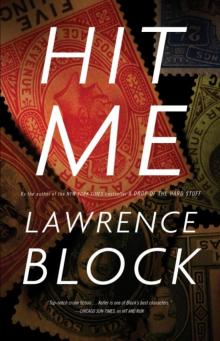 Hit and Run
Hit and Run Hope to Die
Hope to Die Two For Tanner
Two For Tanner Tanners Virgin
Tanners Virgin Dead Girl Blues
Dead Girl Blues One Night Stands and Lost Weekends
One Night Stands and Lost Weekends A Drop of the Hard Stuff
A Drop of the Hard Stuff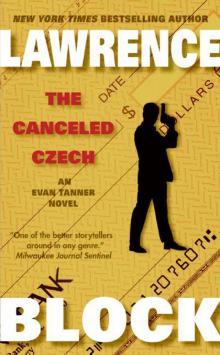 The Canceled Czech
The Canceled Czech Even the Wicked
Even the Wicked Me Tanner, You Jane
Me Tanner, You Jane Quotidian Keller
Quotidian Keller Small Town
Small Town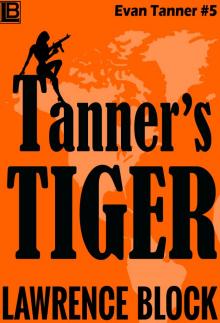 Tanners Tiger
Tanners Tiger A Walk Among the Tombstones
A Walk Among the Tombstones Tanners Twelve Swingers
Tanners Twelve Swingers Gym Rat & the Murder Club
Gym Rat & the Murder Club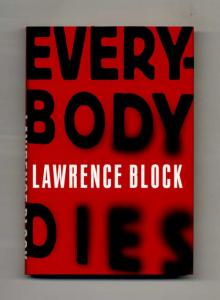 Everybody Dies
Everybody Dies The Thief Who Couldnt Sleep
The Thief Who Couldnt Sleep Hit Parade
Hit Parade The Devil Knows Youre Dead
The Devil Knows Youre Dead The Burglar in Short Order
The Burglar in Short Order A Long Line of Dead Men
A Long Line of Dead Men Keller's Homecoming
Keller's Homecoming Resume Speed
Resume Speed Keller's Adjustment
Keller's Adjustment Eight Million Ways to Die
Eight Million Ways to Die Time to Murder and Create
Time to Murder and Create Out on the Cutting Edge
Out on the Cutting Edge A Dance at the Slaughter House
A Dance at the Slaughter House In the Midst of Death
In the Midst of Death When the Sacred Ginmill Closes
When the Sacred Ginmill Closes You Could Call It Murder
You Could Call It Murder Keller on the Spot
Keller on the Spot A Ticket to the Boneyard
A Ticket to the Boneyard A Time to Scatter Stones
A Time to Scatter Stones Keller's Designated Hitter
Keller's Designated Hitter A Stab in the Dark
A Stab in the Dark Sins of the Fathers
Sins of the Fathers The Burglar in the Closet
The Burglar in the Closet Burglar Who Dropped In On Elvis
Burglar Who Dropped In On Elvis The Burglar Who Painted Like Mondrian
The Burglar Who Painted Like Mondrian The Girl With the Long Green Heart
The Girl With the Long Green Heart The Burglar Who Counted the Spoons (Bernie Rhodenbarr)
The Burglar Who Counted the Spoons (Bernie Rhodenbarr) Burglar Who Smelled Smoke
Burglar Who Smelled Smoke Rude Awakening (Kit Tolliver #2) (The Kit Tolliver Stories)
Rude Awakening (Kit Tolliver #2) (The Kit Tolliver Stories) Don't Get in the Car (Kit Tolliver #9) (The Kit Tolliver Stories)
Don't Get in the Car (Kit Tolliver #9) (The Kit Tolliver Stories) CH04 - The Topless Tulip Caper
CH04 - The Topless Tulip Caper You Can Call Me Lucky (Kit Tolliver #3) (The Kit Tolliver Stories)
You Can Call Me Lucky (Kit Tolliver #3) (The Kit Tolliver Stories) CH02 - Chip Harrison Scores Again
CH02 - Chip Harrison Scores Again Strangers on a Handball Court
Strangers on a Handball Court Cleveland in My Dreams
Cleveland in My Dreams Clean Slate (Kit Tolliver #4) (The Kit Tolliver Stories)
Clean Slate (Kit Tolliver #4) (The Kit Tolliver Stories) The Burglar Who Traded Ted Williams
The Burglar Who Traded Ted Williams Burglar on the Prowl
Burglar on the Prowl In For a Penny (A Story From the Dark Side)
In For a Penny (A Story From the Dark Side) Catch and Release Paperback
Catch and Release Paperback Ride A White Horse
Ride A White Horse No Score
No Score Looking for David (A Matthew Scudder Story Book 7)
Looking for David (A Matthew Scudder Story Book 7)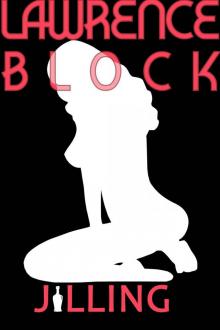 Jilling (Kit Tolliver #6) (The Kit Tolliver Stories)
Jilling (Kit Tolliver #6) (The Kit Tolliver Stories) Ariel
Ariel Enough Rope
Enough Rope Grifter's Game
Grifter's Game Canceled Czech
Canceled Czech Unfinished Business (Kit Tolliver #12) (The Kit Tolliver Stories)
Unfinished Business (Kit Tolliver #12) (The Kit Tolliver Stories) Thirty
Thirty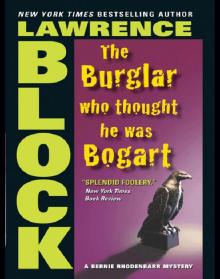 The Burglar Who Thought He Was Bogart
The Burglar Who Thought He Was Bogart Make Out with Murder
Make Out with Murder One Last Night at Grogan's (A Matthew Scudder Story Book 11)
One Last Night at Grogan's (A Matthew Scudder Story Book 11) The Burglar on the Prowl
The Burglar on the Prowl Welcome to the Real World (A Story From the Dark Side)
Welcome to the Real World (A Story From the Dark Side) Keller 05 - Hit Me
Keller 05 - Hit Me Walk Among the Tombstones: A Matthew Scudder Crime Novel
Walk Among the Tombstones: A Matthew Scudder Crime Novel Ronald Rabbit Is a Dirty Old Man
Ronald Rabbit Is a Dirty Old Man The Burglar Who Studied Spinoza
The Burglar Who Studied Spinoza The Burglar Who Liked to Quote Kipling
The Burglar Who Liked to Quote Kipling Keller in Des Moines
Keller in Des Moines Hit List
Hit List The Dettweiler Solution
The Dettweiler Solution HCC 115 - Borderline
HCC 115 - Borderline A Drop of the Hard Stuff: A Matthew Scudder Novel
A Drop of the Hard Stuff: A Matthew Scudder Novel Step by Step
Step by Step The Girl With the Deep Blue Eyes
The Girl With the Deep Blue Eyes If You Can't Stand the Heat (Kit Tolliver #1) (The Kit Tolliver Stories)
If You Can't Stand the Heat (Kit Tolliver #1) (The Kit Tolliver Stories) The Topless Tulip Caper
The Topless Tulip Caper Dolly's Trash & Treasures (A Story From the Dark Side)
Dolly's Trash & Treasures (A Story From the Dark Side) The Triumph of Evil
The Triumph of Evil Fun with Brady and Angelica (Kit Tolliver #10 (The Kit Tolliver Stories)
Fun with Brady and Angelica (Kit Tolliver #10 (The Kit Tolliver Stories) Burglars Can't Be Choosers
Burglars Can't Be Choosers Who Knows Where It Goes (A Story From the Dark Side)
Who Knows Where It Goes (A Story From the Dark Side) Deadly Honeymoon
Deadly Honeymoon Like a Bone in the Throat (A Story From the Dark Side)
Like a Bone in the Throat (A Story From the Dark Side) A Chance to Get Even (A Story From the Dark Side)
A Chance to Get Even (A Story From the Dark Side)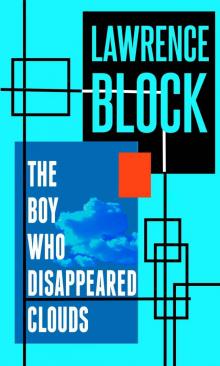 The Boy Who Disappeared Clouds
The Boy Who Disappeared Clouds Collecting Ackermans
Collecting Ackermans Waitress Wanted (Kit Tolliver #5) (The Kit Tolliver Stories)
Waitress Wanted (Kit Tolliver #5) (The Kit Tolliver Stories) One Thousand Dollars a Word
One Thousand Dollars a Word Even the Wicked: A Matthew Scudder Novel (Matthew Scudder Mysteries)
Even the Wicked: A Matthew Scudder Novel (Matthew Scudder Mysteries) Hit Man
Hit Man The Night and The Music
The Night and The Music Ehrengraf for the Defense
Ehrengraf for the Defense The Merciful Angel of Death (A Matthew Scudder Story Book 5)
The Merciful Angel of Death (A Matthew Scudder Story Book 5) The Burglar in the Rye
The Burglar in the Rye I Know How to Pick 'Em
I Know How to Pick 'Em Getting Off hcc-69
Getting Off hcc-69 Three in the Side Pocket (A Story From the Dark Side)
Three in the Side Pocket (A Story From the Dark Side)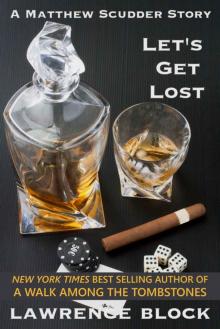 Let's Get Lost (A Matthew Scudder Story Book 8)
Let's Get Lost (A Matthew Scudder Story Book 8) Strange Are the Ways of Love
Strange Are the Ways of Love MOSTLY MURDER: Till Death: a mystery anthology
MOSTLY MURDER: Till Death: a mystery anthology Masters of Noir: Volume Four
Masters of Noir: Volume Four A Week as Andrea Benstock
A Week as Andrea Benstock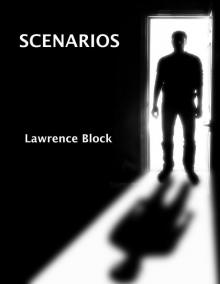 Scenarios (A Stoiry From the Dark Side)
Scenarios (A Stoiry From the Dark Side) The Sex Therapists: What They Can Do and How They Do It (John Warren Wells on Sexual Behavior Book 15)
The Sex Therapists: What They Can Do and How They Do It (John Warren Wells on Sexual Behavior Book 15)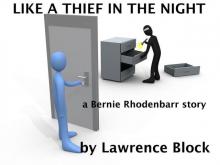 Like a Thief in the Night: a Bernie Rhodenbarr story
Like a Thief in the Night: a Bernie Rhodenbarr story A Diet of Treacle
A Diet of Treacle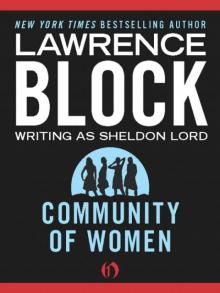 Community of Women
Community of Women Different Strokes: How I (Gulp!) Wrote, Directed, and Starred in an X-rated Movie (John Warren Wells on Sexual Behavior)
Different Strokes: How I (Gulp!) Wrote, Directed, and Starred in an X-rated Movie (John Warren Wells on Sexual Behavior) You Don't Even Feel It (A Story From the Dark Side)
You Don't Even Feel It (A Story From the Dark Side) Zeroing In (Kit Tolliver #11) (The Kit Tolliver Stories)
Zeroing In (Kit Tolliver #11) (The Kit Tolliver Stories) The Wife-Swap Report (John Warren Wells on Sexual Behavior)
The Wife-Swap Report (John Warren Wells on Sexual Behavior) Keller's Fedora (Kindle Single)
Keller's Fedora (Kindle Single) Speaking of Lust
Speaking of Lust Everybody Dies (Matthew Scudder)
Everybody Dies (Matthew Scudder) Defender of the Innocent: The Casebook of Martin Ehrengraf
Defender of the Innocent: The Casebook of Martin Ehrengraf After the First Death
After the First Death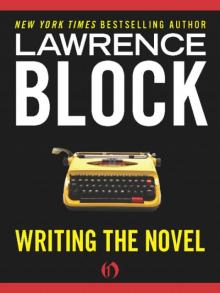 Writing the Novel
Writing the Novel How Far - a one-act stage play
How Far - a one-act stage play Chip Harrison Scores Again
Chip Harrison Scores Again The Topless Tulip Caper ch-4
The Topless Tulip Caper ch-4 The Crime of Our Lives
The Crime of Our Lives Killing Castro
Killing Castro The Trouble with Eden
The Trouble with Eden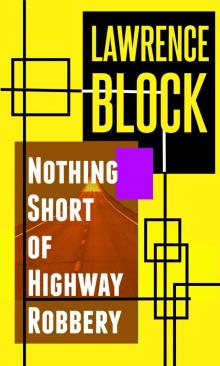 Nothing Short of Highway Robbery
Nothing Short of Highway Robbery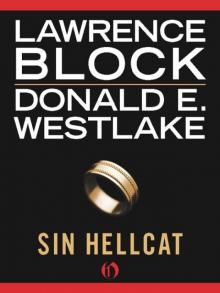 Sin Hellcat
Sin Hellcat Getting Off: A Novel of Sex & Violence (Hard Case Crime)
Getting Off: A Novel of Sex & Violence (Hard Case Crime) Coward's Kiss
Coward's Kiss Alive in Shape and Color
Alive in Shape and Color Blow for Freedom
Blow for Freedom The New Sexual Underground: Crossing the Last Boundaries (John Warren Wells on Sexual Behavior Book 10)
The New Sexual Underground: Crossing the Last Boundaries (John Warren Wells on Sexual Behavior Book 10) April North
April North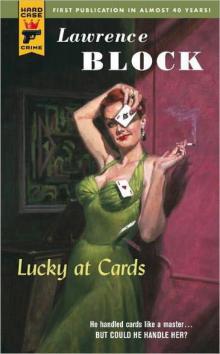 Lucky at Cards
Lucky at Cards One Night Stands; Lost weekends
One Night Stands; Lost weekends Sweet Little Hands (A Story From the Dark Side)
Sweet Little Hands (A Story From the Dark Side) Blood on Their Hands
Blood on Their Hands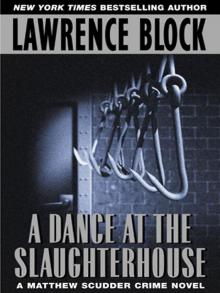 A Dance at the Slaughterhouse
A Dance at the Slaughterhouse Headaches and Bad Dreams (A Story From the Dark Side)
Headaches and Bad Dreams (A Story From the Dark Side) Keller's Therapy
Keller's Therapy The Specialists
The Specialists Hit and Run jk-4
Hit and Run jk-4 Threesome
Threesome Love at a Tender Age (John Warren Wells on Sexual Behavior)
Love at a Tender Age (John Warren Wells on Sexual Behavior) The Devil Knows You're Dead: A MATTHEW SCUDDER CRIME NOVEL
The Devil Knows You're Dead: A MATTHEW SCUDDER CRIME NOVEL Funny You Should Ask
Funny You Should Ask CH01 - No Score
CH01 - No Score Sex and the Stewardess (John Warren Wells on Sexual Behavior)
Sex and the Stewardess (John Warren Wells on Sexual Behavior) A Madwoman's Diary
A Madwoman's Diary When This Man Dies
When This Man Dies Sinner Man
Sinner Man Such Men Are Dangerous
Such Men Are Dangerous A Strange Kind of Love
A Strange Kind of Love Enough of Sorrow
Enough of Sorrow 69 Barrow Street
69 Barrow Street A Moment of Wrong Thinking (Matthew Scudder Mysteries Series Book 9)
A Moment of Wrong Thinking (Matthew Scudder Mysteries Series Book 9) Eight Million Ways to Die ms-5
Eight Million Ways to Die ms-5 Warm and Willing
Warm and Willing Mona
Mona In Sunlight or In Shadow
In Sunlight or In Shadow A Candle for the Bag Lady (Matthew Scudder Book 2)
A Candle for the Bag Lady (Matthew Scudder Book 2) Conjugal Rites (Kit Tolliver #7) (The Kit Tolliver Stories)
Conjugal Rites (Kit Tolliver #7) (The Kit Tolliver Stories)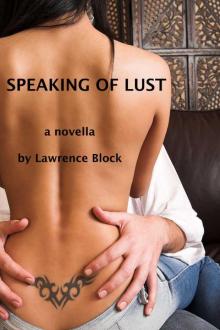 Speaking of Lust - the novella
Speaking of Lust - the novella Gigolo Johnny Wells
Gigolo Johnny Wells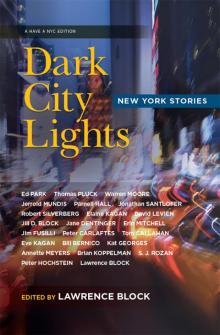 Dark City Lights
Dark City Lights Versatile Ladies: the bisexual option (John Warren Wells on Sexual Behavior)
Versatile Ladies: the bisexual option (John Warren Wells on Sexual Behavior) Passport to Peril
Passport to Peril The Taboo Breakers: Shock Troops of the Sexual Revolution (John Warren Wells on Sexual Behavior)
The Taboo Breakers: Shock Troops of the Sexual Revolution (John Warren Wells on Sexual Behavior) Lucky at Cards hcc-28
Lucky at Cards hcc-28 Campus Tramp
Campus Tramp 3 is Not a Crowd (John Warren Wells on Sexual Behavior)
3 is Not a Crowd (John Warren Wells on Sexual Behavior)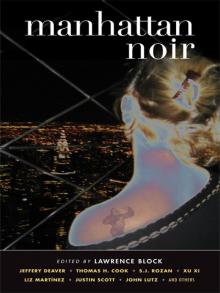 Manhattan Noir
Manhattan Noir The Burglar in the Library
The Burglar in the Library Doing It! - Going Beyond the Sexual Revolution (John Warren Wells on Sexual Behavior Book 13)
Doing It! - Going Beyond the Sexual Revolution (John Warren Wells on Sexual Behavior Book 13) So Willing
So Willing The Burglar Who Traded Ted Williams br-6
The Burglar Who Traded Ted Williams br-6 Candy
Candy Sex Without Strings: A Handbook for Consenting Adults (John Warren Wells on Sexual Behavior)
Sex Without Strings: A Handbook for Consenting Adults (John Warren Wells on Sexual Behavior) The Devil Knows You're Dead: A MATTHEW SCUDDER CRIME NOVEL (Matthew Scudder Mysteries)
The Devil Knows You're Dead: A MATTHEW SCUDDER CRIME NOVEL (Matthew Scudder Mysteries) Manhattan Noir 2
Manhattan Noir 2 The Scoreless Thai (aka Two For Tanner)
The Scoreless Thai (aka Two For Tanner)